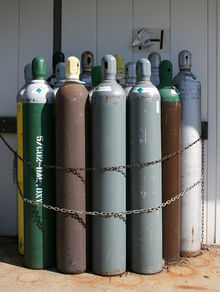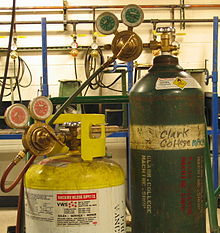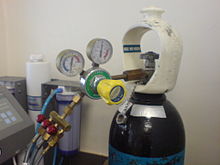- Gas cylinder
-
For the mechanical devices used to impart a force from a pressurized liquid or gas, see pneumatic cylinder. For the large structures used to store town gas, see gas holder.
A gas cylinder is a pressure vessel used to store gases at above atmospheric pressure. High pressure gas cylinders are also called bottles. Although they are sometimes colloquially called "tanks", this is technically incorrect, as a tank is a vessel used to store liquids at ambient pressure and often has an open top.
Contents
Nomenclature differences
In the United States, "bottled gas" typically refers to liquefied petroleum gas. "Bottled gas" is sometimes used in medical supply, especially for portable oxygen tanks. Packaged industrial gases are frequently called "cylinder gas", though "bottled gas" is sometimes used.
The United Kingdom and other parts of Europe more commonly refer to "bottled gas" when discussing any usage whether industrial, medical or liquefied petroleum. However, in contrast, what the United States calls liquefied petroleum gas is known generically in the United Kingdom as "LPG"; and it may be ordered using by one of several Trade names, or specifically as butane or propane depending on the required heat output.
Materials
For a detailed discussion about the materials for gas cylinders see Pressure vessel.
Design codes and application standards along with the cost of materials dictated the choice of steel with no weldings for most gas cylinders, treated to be anti corrosive. There have been some newly developed lightweight gas cylinders from composite materials. Due to the very high tensile strength of carbon fibre, these vessels can be very light, but are much more difficult to manufacture.[1]
Regulations and cylinder testing
The transportation of high pressure cylinders is regulated by many governments throughout the world. Various levels of testing are generally required by the governing authority for the country in which it is to be transported. In the United States, this authority is the United States Department of Transportation (DOT). Similarly in the UK, the European transport regulations (ADR) are implemented by the Department for Transport (DfT). For Canada, this authority is Transport Canada (TC). Cylinders may have additional requirements placed on design and or performance from independent testing agencies such as Underwriter's Laboratory (UL). Each manufacturer of high pressure cylinders is required to have independent quality agent that will inspect the product for quality and safety.
Within the UK the "competent authority" — the DfT — implements the regulations and appointment of authorised cylinder testers is conducted by UKAS, who make recommendations to the VCA for approval of individual bodies.
There are a variety of tests that may be performed on various cylinders. Some of the most common types of tests are hydrostatic test, burst test, tensile strength, Charpy impact test and pressure cycling.
During the manufacturing process, vital information is usually stamped or permanently marked on the cylinder. This information usually includes the type of cylinder, the working or service pressure, the serial number, date of manufacture, the manufacture's registered code and sometimes the test pressure. Other information may also be stamped depending on the regulation requirements.
High pressure cylinders that are used multiple times — as most are — can be hydrostatically or ultrasonically tested and visually examined every few years. In the United States, hydrostatic/ultrasonic testing is required either every five years or every ten years, depending on cylinder and its service. Helium gas cylinders have the highest pressures possible when full, around 1000 atmospheres.[citation needed]
Valve connections
When gases are supplied in gas cylinders, the cylinders have a stop angle valve at the end on top. Often, gas cylinders are somewhat long and narrow and may stand upright on a flattened bottom at one end with the valve at the top. During storage, transportation, and handling when the gas is not in use, a cap may be screwed over the protruding valve to protect it from damage or breaking off in case the cylinder were to fall over. Instead of a cap, cylinders commonly have a protective collar or neck ring around the service valve assembly.
When the gas in the cylinder is ready to be used, the cap is taken off and a pressure-regulating assembly is attached to the stop valve. This attachment typically has a pressure regulator with upstream (inlet) and downstream (outlet) pressure gauges and a further downstream needle valve and outlet connection. For gases that remain gaseous under ambient storage conditions, the upstream pressure gauge can be used to estimate how much gas is left in the cylinder according to pressure. For gases that are liquid under storage, e.g., propane, the outlet pressure is dependent on the vapor pressure of the gas, and does not fall until the cylinder is nearly exhausted. The regulator could be adjusted to control the flow of gas out of the cylinder according to pressure shown by the downstream gauge. The outlet connection is attached to whatever needs the gas supply, such as a balloon for example.
The valves on industrial, medical and diving cylinders are usually of different size and type, as are the valves for different products, making it more difficult to mistakenly misuse a gas. Some fittings use a right-hand thread, while others use a left-hand thread; left-hand thread fittings are usually identifiable by notches cut into them.
In the United States, valve connections are sometimes referred to as "CGA connections," since the Compressed Gas Association (CGA) publishes guidelines on what connections to use for what products, e.g., In the United States, an argon cylinder will have a CGA 580 connection on the valve.
High purity gases will sometimes use CGA-DISS ("Diameter Index Safety System") connections.
In the EU, DIN connections are more common than in the United States.
Safety and standards
 Good Handling: Gas cylinders chained to a wall for safety at Duke University. Note the protective caps covering the valves at top of each cylinder.
Good Handling: Gas cylinders chained to a wall for safety at Duke University. Note the protective caps covering the valves at top of each cylinder.
Because the contents are under pressure and are sometimes hazardous, there are special safety regulations for handling bottled gases. These include chaining bottles to prevent falling and breaking, proper ventilation to prevent injury or death in case of leaks and signage to indicate the potential hazards. Installing and replacing gas cylinders should be done by trained personnel. If a compressed gas cylinder tips over, causing the valve block to be sheared off, the rapid release of high pressure gas may cause the cylinder to be violently accelerated, potentially causing property damage, injury, or death. To prevent this, cylinders are normally secured to a fixed object or transport cart with a strap or chain.
In a fire, the pressure in a gas cylinder rises in direct proportion to its temperature. If the internal pressure exceeds the mechanical limitations of the cylinder and there are no means to safely vent the pressurized gas to the atmosphere, the vessel will fail mechanically. If the vessel contents are ignitable, this event may result in a "fireball". If the cylinder's contents are liquid, but become a gas at ambient conditions, this is commonly referred to as a Boiling Liquid Expanding Vapour Explosion (BLEVE).
Medical gas cylinders in the UK and other countries have a seal of Wood's metal between the valve block and the cylinder body. This seal melts at a comparatively low temperature (70°C) and allows the contents of the cylinder to escape in a controlled fashion, lessening the risk of explosion.
More common pressure relief devices are of a simple burst disc type. In these, a small burst disc is installed in the back of the valve. A burst disc is a small metal gasket engineered to rupture at a pre-determined pressure. Some burst discs are backed with a low-melting-point metal, so that the valve must be exposed to excessive heat before the burst disc can rupture.
The Compressed Gas Association sells a number of booklets and pamphlets on safe handling and use of bottled gases.
Cylinders should be properly labeled and securely stored. Substances that may react with each other, e.g., oxidizers and flammable materials, should not be stored in close proximity.[2]
International and US standards
- ISO 11439: Gas cylinders — High pressure cylinders for the on-board storage of natural gas as a fuel for automotive vehicles [3]
- ISO 15500-5: Road vehicles — Compressed natural gas (CNG) fuel system components — Part 5: Manual cylinder valve [4][5]
- US DOT 3/4/8???: e-CFR (Electronic Code of Federal Regulations) Title 49, part 178, Subpart C - Specification for Cylinders [6]
- US DOT Aluminum Tank Alloy 6351-T6 ammendment for SCUBA, SCBA, Oxygen Service - Visual Eddy inspection [7]
Color coding
Gas cylinders are often color coded, but the codes are not standard across different jurisdictions, and sometimes are not regulated. Cylinder color can not safely be used for positive product identification; cylinders have labels to identify the gas they contain and the label alone should be used for positive identification.
Common cylinder sizes
In scuba diving, the United States measures cylinder volume by the amount of free air that can be compressed into the cylinder; Europe measures the cylinder volume as the internal volume of the cylinder: e.g. United States 19 cubic feet = European 3 liter at 180 bar.
The below are example cylinder sizes and do not constitute an industry standard.[8]
Cyl. Size Size* Diameter X Height (inches) Includes 5.5 inches for valve and cap. Nominal* Tare Weight (lbs.) Includes 4.5 lbs. for valve and cap. Water Capacity (lbs.) Internal Volume @ 70°F (21°C), 1 ATM liters (cubic feet) U.S. DOT Specs K 9.25 X 60 135 110 49.9 (1.76) 3AA2400 A 9 X 51 115 96 43.8 (1.55) 3AA2015 B 8.5 X 31 60 37.9 17.2 (0.61) 3AA2015 C 6 X 24 27 15.2 6.88 (0.24) 3AA2015 D 4 X 18 12 4.9 2.24 (0.08) 3AA2015 AL 8 X 53 52 64.8 29.5 (1.04) 3AL2015 BL 7.25 X 39 33 34.6 15.7 (0.55) 3AL2216 CL 6.9 X 21 19 13 5.9 (0.21) 3AL2216 XL 14.5 X 50 75 238 108 (3.83) 4BA240 SSB 8 X 37 95 41.6 18.9 (0.67) 3A1800 10S 4 X 31 21 8.3 3.8 (0.13) 3A1800 LB 2 X 15 4 1 0.44 (0.016) 3E1800 XF 12 X 46 180 60.9 (2.15) 8AL XG 15 X 56 149 278 126.3 (4.46) 4AA480 XM 10 X 49 90 120 54.3 (1.92) 3A480 XP 10 X 55 55 124 55.7 (1.98) 4BA300 QT 3 X 14 includes 4.5 inches for valve 2.5 includes 1.5 lbs for valve 2.0 0.900 (0.0318) 4B-240ET LP5 12.25 X 18.25 18.5 47.7 21.68 (0.76) 4BW240 Medical E 4 x 26 excludes valve and cap 14 excludes valve and cap 4.5 (0.16) 3AA2015 See also
- Bottled gas
- Pressure vessel
- Carbon fiber
- Composite overwrapped pressure vessel
- Filling Carousel
- Industrial gas
- Storage tank
- UN Recommendations on the Transport of Dangerous Goods
References
- ^ See Composite overwrapped pressure vessel for details
- ^ Air cylinder:http://www.nuolin.com/news/Gas-Cylinder-Management.htm
- ^ Gas cylinders — High pressure cylinders for the on-board storage of natural gas as a fuel for automotive vehicles
- ^ Road vehicles — Compressed natural gas (CNG) fuel system components — Part 5: Manual cylinder valve
- ^ ISO 15500 overview and FAQ
- ^ US DOT e-CFR (Electronic Code of Federal Regulations) Title 49, part 178, Subpart C - Specification for Cylinders - eg DOT 3AL = seamless aluminum
- ^ Federal Register / Vol. 71, No. 167 / Tuesday, August 29, 2006 / Rules and Regulations Title 49 CFR Parts 173 and 180 Visual Edddy
- ^ Specialty Gas Cylinder Dimensions Air Products
Categories:- Pressure vessels
- Anesthetic equipment
- Gas technologies
- Containers
Wikimedia Foundation. 2010.


